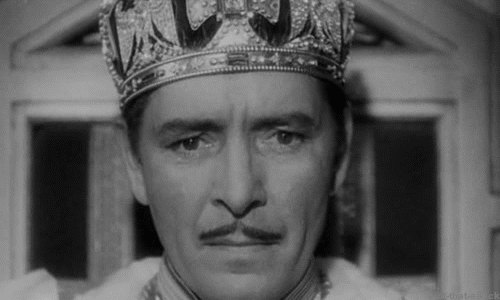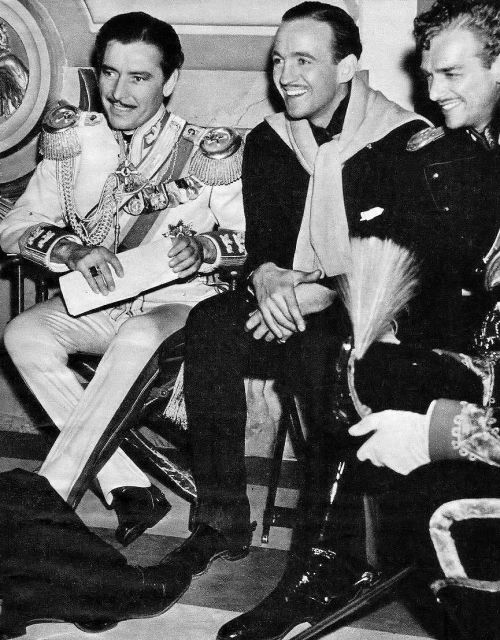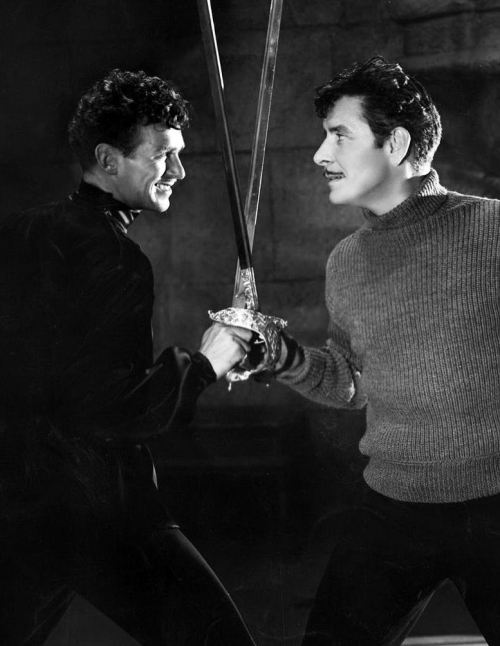A
“visão dupla” é uma das técnicas mais ricas, mais exploradas e mais comentadas
na mídia filmada. Até hoje, quando um ator interpreta dois papéis em um só
filme ou programa de TV, é gerada uma curiosidade e surgem alguns artigos em
sites e revistas sobre como o efeito foi criado. Com técnicas de edição,
pintura mate e o uso de sombras, não é muito difícil ter “dublês” em filmes. E,
em 1937, a técnica foi usada com perfeito realismo em “O Prisioneiro de Zenda”.
“Seeing double” is one of the richest, more commonly
explored and more talked about techniques in filmmaking. Until today, when an actor
plays two roles in the same movie or TV production, there is curiosity and a
few articles in sites and magazines about how the effect was achieved. With
editing, matte paintings and the use of shadows, it isn't really that difficult
to have doubles in a film. And in 1937, the technique was used with perfect
realism in “The Prisoner of Zenda”.
O
entusiasta da pesca inglês Rudolf Rassendyll (Ronald Colman) chega em um país
europeu fictício perto da Áustria e da Romênia e chama a atenção de todos. Há
uma razão para isso: ele é um sósia do príncipe do lugar, que será coroado rei
no dia seguinte.
English fishing enthusiast Rudolf Rassendyll (Ronald
Colman) arrives in a fictional European country near Austria and Rumania and
calls everybody's attention. There is a reason for that: he looks exactly like
the prince of the place, who will be crowned king the following day.
Não
demora muito até que o príncipe Rudolf (também Ronald Colman) encontra 0 inglês
Rudolf e o convida para celebrar o encontro em uma taverna – porque o príncipe
tem um probleminha com a bebida. Logo seus companheiros, Rudolf e Fritz (David
Niven) caem no sono, e o príncipe decide fazer um último brinde – com um vinho
que foi envenenado por seu irmão usurpador, Michael (Raymond Massey).
It doesn't take long until the prince Rudolf (also
Ronald Colman) finds the Englishman Rudolf and invites him to a tavern to
celebrate their meeting – because the prince has a little problem with alcohol.
Soon his companions, Rudolf and Fritz (David Niven) are asleep, and the prince
decides to take one last toast – with a wine that happens to have been poisoned
by his envious brother, Michael (Raymond Massey).
No dia
seguinte, o príncipe está em coma. A única solução encontrada pelo coronel Zapt
(C. Aubrey Smith), conselheiro do príncipe, é colocar Rudolf no lugar do
príncipe durante a coroação para evitar um escândalo. Rudolf faz isso, e algo
mais: ele se apaixona pela noiva do príncipe, a princesa Flavia (Madeleine
Carroll). Mas a mentira terá de durar mais que o esperado, porque o capanga de
Michael, conde Rupert de Hentzau (Douglas Fairbanks Jr) encontrou e raptou o
príncipe.
The next day, the prince is comatose. The only
solution found by Colonel Zapt (C. Aubrey Smith), the prince's counselor, is
for Rudolf to replace the prince in the coronation to avoid a scandal. Rudolf
does this, and more: he falls in love with the prince's fiancée, Princess
Flavia (Madeleine Carroll). But the lie will have to last longer than intended,
because Michael's minion, Count Rupert of Hentzau (Douglas Fairbanks Jr) have
found and kidnapped the real prince.
“O
Prisioneiro de Zenda” tem um grande elenco. Você acabou de ver: Colman,
Carroll, Massey, Fairbanks Jr, Niven, C. Aubrey Smith – um dos meus favoritos –
e Mary Astor como Antoinette, uma garota apaixonada por Michael. Douglas
Fairbanks Jr havia feito teste para o duplo papel protagonista, mas Colman foi
escalado, o que devastou o jovem atlético. Seu pai, o ídolo Douglas Fairbanks,
disse que o papel de Rupert era, na verdade, “uma bênção disfarçada”.
“The Prisoner of Zenda” has a great cast. You just
read: Colman, Carroll, Massey, Fairbanks Jr, Niven, C. Aubrey Smith – a
personal favorite – and Mary Astor as Antoinette, the girl in love with
Michael. Douglas Fairbanks Jr had tested for the double leading role, but
Colman got it instead, which devastated the young athletic man. His father, the
swashbuckling idol Douglas Fairbanks, said that the role of Rupert was actually
“a blessing in disguise”.
E o
velho Fairbanks tinha razão. Embora Rudolf seja a estrela e Colman seja ao
mesmo tempo charmoso, brincalhão e destemido – Rupert é também um ótimo
personagem – e talvez até mais interessante. Rupert é esperto e leal apenas a
si mesmo. Ele é ambicioso, corajoso e ousado. E ele se envolve em uma luta de
esgrima fantástica e climática contra Rudolf – uma sequência que só ficou
completa com vívidas sombras dos dois duelando.
And the old Fairbanks was right. Although Rudolf is
the star and Colman is at the same time charming, playful and daring, Rupert is
also a great – if not more interesting – character. Rupert is smart and loyal
only to himself. He's ambitious, daring and fearless. And he engages in a
fantastic climatic swordfight against Rudolf – a sequence that was made
complete by vivid shadows of them fencing.
Se você
esperava uma produção com cenários maravilhosos, não ficará desapontado. As
duas personagens femininas no filme têm menos substância que as masculinas, com
Mary Astor se saindo melhor que Madeleine Carroll. A atenção de Selznick ao
detalhe ajudou o visual do filme a ser surpreendente – incluindo as três cenas
em que Ronald Colman contracena com “ele mesmo”.
If you expected a production with lavish sets, you
won't be disappointed. The two female characters in the film have less
substance than their male counterparts, with Mary Astor performing better than
Madeleine Carroll. Selznick's attention to detail helped the visuals of the
film to be wonderful – including the three scenes in which Ronald Colman shares
the screen with himself.
“O Prisioneiro
de Zenda” teve diversas adaptações para o cinema, começando em 1913. Esta é a
primeira da era falada, e também a versão definitiva. Ronald Colman adicionou
uma tonelada de carisma aos dois papéis que interpretou, mas são as cenas de
ação e o clímax tenso que tornam o filme extremamente divertido.
“The Prisoner of Zenda” had several adaptations to the
screen, starting in 1913. This one is the first of the sound era, and also the
definitive one. Ronald Colman injected a ton of charisma in his two roles but
the action scenes and the tense climax are the elements that make the film
extremely enjoyable.
This is my contribution to the Swashaton – The Swashbuckler Blogathon, hosted by Fritzi at Movies, Silently.









11 comments:
This version of The Prisoner of Zenda is magical, and will always have a special place in my heart. It is the sort of movie you hate to see end.
Thank you so much for joining in. I enjoyed your review of this "double vision" as it's one of my favorites as well. Fairbanks Sr. was right! Junior was a dream as a baddie.
Really enjoyed reading your review. This is such a great film. Ronald Colman is perfect in this. Maddy from maddylovesherclassicfilms.
I've always heard about this movie, but never seen it. Looks like a good one! Also looks like there was a "Best Mustache" contest happening on the side. :-)
Apparently Colman didn't think he did his double roles that well -- he didn't went to portray both Darnay and Carton in A Tale of Two Cities, for example. I can see what he meant but who cares? The more Ronald Colman the better!
Great choice for the blogathon, Le! Fabulous cast and great sets and costumes. (And Douglas Fairbanks, Jr. is PERFECT.)
I love what a previous commenter said about a "Best Moustache" contest. I'm going to watch for that the next time I see this film. :)
This is my favourite version of TPoZ - for many reasons, but especially because of Douglas Fairbanks Jr's perfect Rupert, the boy with the sunny smile and the ready knife! I can't help thinking that a dull or "wrong" Rupert is bound to thoroughly ruin an adaptation of Zenda.
Clara @ Scribblings
Marvelous review! I just watched this last month again and thoroughly enjoyed it. That certainly would have been interesting if Fairbanks had played the dual role, but it's hard to wish him in any other role than Rupert. :)
I was actually first introduced to the 1952 Prisoner of Zenda, but once I saw this one, it became my favorite version.
The Zenda story is one that I loved as a kid, when I was a much more avid reader, but I haven't actually seen any versions of it. Not direct versions, anyway, although I have seen a couple of movies inspired by the story.
Hi Lê. I'm happy you wrote about this version of The Prisoner of Zenda. I love the movie and I particularly love both Ronald Colman and Douglas Fairbanks, Jr. C Aubrey Smith and David Niven were very good, too. I agree that Mary Astor did better than Madeline Carrol. I read the book when I was in grammar school, even before I saw the movie. The movie did not disappoint me. The version with Stewart Granger copied this one pretty closely, but the actors were not as good.
I was blown away by this film when I first saw it. I'll admit I was expecting it to be kind of dull, but I was proven completely wrong. The visuals are stunning and the acting is brilliant. Just looking at those photos made me grin. Fantastic choice!
Post a Comment